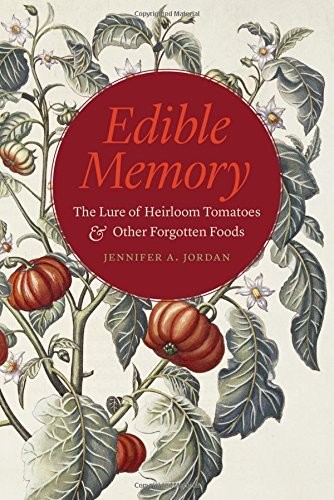Eating a piece of history
September 8, 2015 by Darcie
Go to any farmers’ market and you are bound to see plenty of heirloom vegetables with colorful, historical names, like Cherokee Purple tomatoes or Fordhook acorn squash. But did you ever wonder why we are drawn to these old-fashioned varieties? Sure, many are more flavorful than their store-shelf counterparts, but there is more to it than that. Jennifer Jordan, professor of sociology at the University of Wisconsin, Milwaukee, explains our deep affection for these heirlooms in an interview with Minnesota Public Radio.
In addition to perceived flavor differences, the appeal also comes from nostalgia and from personal associations with these plants. Jordan has recently released a book on this subject called Edible Memory: The Lure of Heirloom Tomatoes and Other Forgotten Foods. It explores the powerful social force of nostalgic foods, and why a “growing number of people seek in heirlooms both a new culinary experience and a connection to a more generalized past.”
Jordan explains that she thinks there are many different reasons why people are drawn to heirloom plants. “Food can be very personal, for example, edible memories within families. Here in Wisconsin, rhubarb patches are really important. If a house gets sold, people vie to get cuttings of the plant. If rhubarb is something you grow up with, you may want to carry it into the future – it’s a very immediate memory. At the other end of the spectrum, a lot of people are interested in experiencing the past at places like colonial Williamsburg, where you get immersed in a sensory experience. Food is another way to do that. I got the idea for the book by thinking about how the heirloom tomato and the antique apple allow you to eat a piece of history.”
Categories
- All Posts (6940)
- Antipasto (2135)
- Author Articles (247)
- Book News (935)
- Cookbook Giveaways (983)
- Cookbook Lovers (257)
- Cooking Tips (109)
- Culinary News (299)
- Food Biz People (552)
- Food Online (791)
- Holidays & Celebrations (272)
- New Cookbooks (149)
- Recipes (1500)
- Shelf Life With Susie (231)
- What's New on EYB (133)
Archives
Latest Comments
- eliza on What foods do you look forward to the most for each season?
- kmwyman on Rooza by Nadiya Hussain – Cookbook Review and Giveaway
- Maryd8822 on The Golden Wok – Cookbook Giveaway
- Dendav on Danube Cookbook Review and Giveaway
- sanfrannative on Rooza by Nadiya Hussain – Cookbook Review and Giveaway
- darty on Danube Cookbook Review and Giveaway
- Atroyer7 on Danube Cookbook Review and Giveaway
- demomcook on What foods do you look forward to the most for each season?
- demomcook on Danube Cookbook Review and Giveaway
- Darcie on How cookbooks can help build resilience